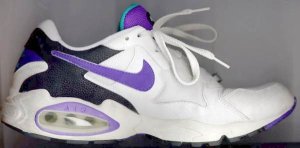
Many Nike shoes use a cushioning technology called "AIR." What details do we have about AIR? Why didn't anyone else come out with a similar product for a long time?
The Nike AIR system was developed by Marion Frank Rudy, an independent inventor in California, and licensed to Nike. As Nike describes it, it is a "pressurized gas encapsulated in polyurethane." However, both the gas and the capsule have interesting properties.
If the gas leaks out of the capsule, it goes flat. Therefore, the Nike AIR design uses a dense gas, so the gas stays inside the capsule. In US Patent 4219945, Mr. Rudy mentions a large number of possible gases, which he describes as "supergases." Generally, the "supergases" are halogenated hydrocarbons, with the exception of sulfur hexafluoride. The patent mentions ethane hexafluoride and sulfur hexafluoride. as being the best two choices. Since "denseness" is proportional to molecular weight, calculations with a periodic table would suggest that the gas is sulfur hexafluoride.
Some Nike shoes list US Patent 5042176, which describes an improved capsule material that can be inflated with nitrogen. Nitrogen has price and environmental advantages over the traditional Nike AIR "supergases" listed in US Patent 4219945.
US Patent 4219945 mentions a large number of different plastic and rubber materials that will work. However, the patent recommends a polyurethane film. Nike, while not describing the gas in their SEC filing, does indeed state that the plastic is polyurethane.
Also, US Patent 4936029 and US Patent 5042176 describe the use of crystalline materials in the Nike AIR capsule that enhance the capsule stability over time. US Patent 6013340 describes a polyester polyol-urethane composite suitable for a Nike AIR capsule, and some Nike shoes list this patent.
It does, because of characteristics of the film and the inert gas!
The polyurethane film is somewhat porous to oxygen and nitrogen, while being insufficiently porous to allow the inert gas to escape. Any gas will expand into an area where it is not present, if allowed to. Since the dense gas is neither oxygen or nitrogen, oxygen and nitrogen in the air slowly migrates through the polyurethane film into the Nike AIR chamber. This can result in significant pressure increases over time. as the migration ceases when the gas partial pressures are the same on both sides. Marion Frank Rudy also received US Patent 4340626 for that ingenious application of the laws of physics.
US Patent 5042716 also performs the same trick, using nitrogen inside the AIR capsule. However, in this case, only the non-nitrogen gases in the air diffuse into the AIR capsule.
In the opinion of Nike customers: Some of the best athletic shoes ever developed!
![]() Back to the top of Charlie's Sneaker
Pages!
Back to the top of Charlie's Sneaker
Pages!
Last Updated: 14 August 2017
Click here to send E-mail to Charlie.
Charlie's Sneaker Pages copyright 1995-2024 by Charles L. Perrin.
READERS PLEASE NOTE: Names of athletic shoe manufacturers, shoe styles, and technologies may be trademarked by the manufacturers. Charlie's Sneaker Pages uses these names solely to describe the shoes with the same familiar nomenclature used by the manufacturer and recognized by the reader.